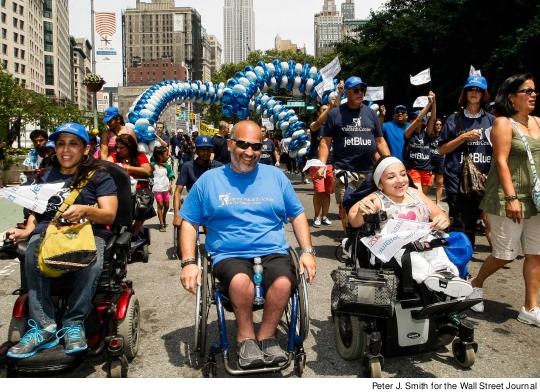 |
For many workers, the Americans with Disabilities Act (ADA), first passed into law 25 years ago, finally provided a clear and comprehensive elimination of disability-based discrimination in the workplace. New York City celebrated the silver anniversary of the ADA this year by hosting the first annual New York City Disability Pride Parade on July 12. The parade attracted thousands of onlookers, who cheered on about some 3,000 disabled parade participants.
The prevalence of such ADA hallmarks as ramps and elevators to provide access to people with limited mobility are among its most visible accomplishments, but the range of conditions covered by the law include many that are less obvious.
Landmark Legislation
The ADA defines a person with a disability as someone “who has a physical or mental impairment that substantially limits one or more major life activities, a person who has a history or record of such an impairment, or a person who is perceived by others as having such an impairment.”
A basic tenet of the ADA is that many people with disabilities are capable of work, especially if they are provided “reasonable accommodation” that does not impose an “undue hardship” on their employers.
An undue hardship is described as an excessive cost, substantive enough to disrupt the fundamental nature or even operation of a business. One example of a reasonable accommodation is job restructuring. For example, let’s say that someone who has a severe hearing impairment works in an office in which answering the phone is a non-essential job function of the position occupied by the disabled person, thus allowing the task to be reassigned to the employee’s office colleagues. Another example for a person with a manual disability could be the provision of office equipment in the form of a telephone headset, adaptive light switches or even a speaker phone. This site lists more examples of reasonable accommodation.
Straightforward Process
Susan Kopp, a veterinarian and professor at LaGuardia College who has presented at national education meetings on the proper handling of student disability issues, went through the process of requesting her own reasonable accommodation. “The process was straightforward and collaborative between Human Resources and my own academic department, and all in accordance with ADA guidelines,” she says.
Redefined Standards
The ADA’s original mandate was bold in nature, but due to subsequent Supreme Court rulings, it came to be interpreted more narrowly. After the courts disqualified many claims of disability – even though the plaintiffs suffered from epilepsy, depression, diabetes and a range of other conditions that an average person might view as a disability – Congress realized the limiting effects these judicial interpretations were having and, in 2008, passed the ADA Amendments Act (ADAAA), which both redefined and broadened the meaning of disability.
The ADAAA and the final regulations define a disability using a three-pronged approach:
- a physical or mental impairment that substantially limits one or more major life activities (sometimes referred to in the regulations as an “actual disability”), or
- a record of a physical or mental impairment that substantially limited a major life activity (“record of”), or
- when a covered entity takes an action prohibited by the ADA because of an actual or perceived impairment that is not both transitory and minor.
If you believe you may be eligible to receive a reasonable accommodation, contact your employer for information on the benefits afforded to you under the ADA and ADAAA.
______________________________
Jared Herst is the PSC’s coordinator of pension and health benefits.

